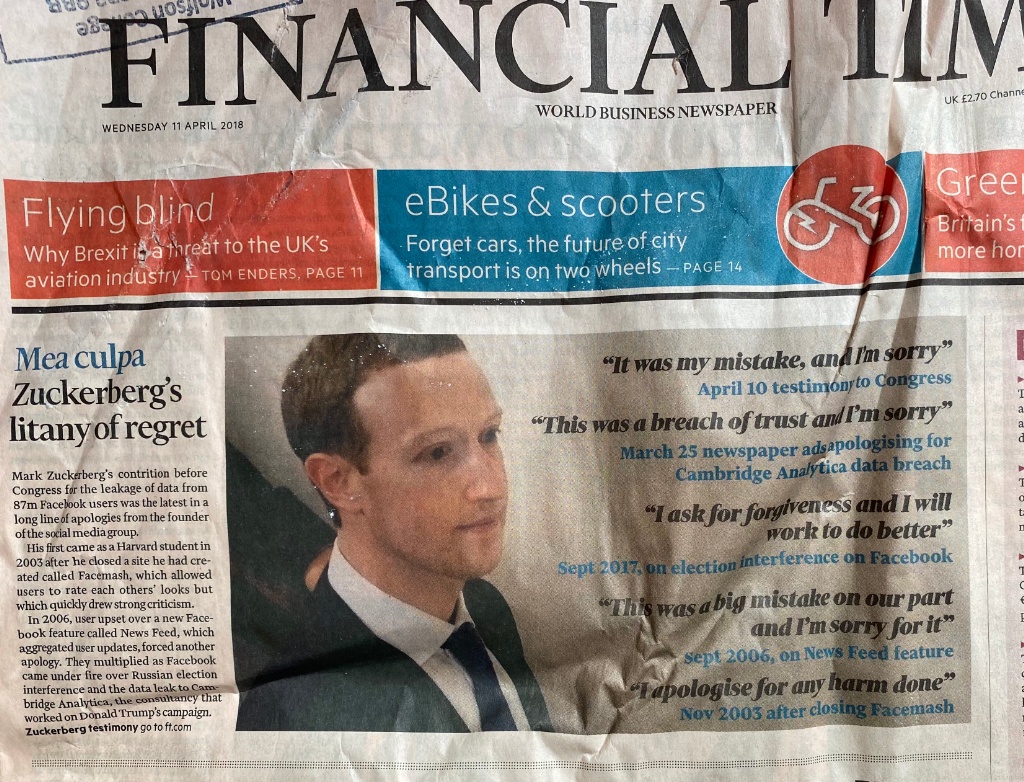At last: a good use for a Zuckerberg
Turns out, we used this issue of the Financial Times to line a cupboard in our utility room!
Sheila Hayman on ‘The Dig’
My appreciative encomium of the Netflix film, The Dig, yesterday prompted a wonderful blast from Sheila Hayman, a terrific film-maker who is on the Advisory Board of our new Research Centre. It reads:
For the sake of your female – and perhaps more, male – readers, I really, really would like you to at least know the truth about The Dig
1 Edith Pretty was 55 years old in 1938. She was not a lissom flower, but a radical who refused a CBE for Sutton Hoo as she disapproved of the honours system.
2 The photographer was not a handsome young man, but two women, Mercie Lack ARPS and Barbara Wagstaff ARPS. After the war, they both successfully submitted for membership to the Royal Photographers Society, using their photo essays of the excavation at Sutton Hoo. Their work in documenting the excavation was vitally important. The archive of 447 photographs taken on Leica cameras, 72 Agfa 35mm colour slides and film of Basil Brown excavating captured on a 16mm cine-camera, today forms a critical component of the excavation record. Their work at Sutton Hoo included some of the first colour images in British archaeology (I included all this detail as, being a photographer, I thought you might like it.)
3 Peggy Piggott was not a naive slip of a girl, but a highly qualified and experienced field archaeologist.
4 Dorothy May Brown was far from a neglected, lonely wife; Basil wrote to her all the time.
For all of this I am grateful to this blog and the researches of my equally pissed off female friends).
A few thoughts sparked by Sheila’s message.
- It provides yet another confirmation of my view that one of the great consolations of blogging is the fact that one’s readers are often/usually better informed than oneself!
- It also illustrates the fact that making a feature film with an eye on Oscar nominations always means (a) being economical with the actualité (as Alan Clark used to say); (b) introducing simplifications and distractions (like the apparently dysfunctional marriage of Peggy Piggott); (c) twisting the story to provide an opening for attractive actors — making Edith Pretty a tragic lissom flower with heart trouble rather than the doughty 58-year old she was at the time; having a handsome male photographer to record the excavation rather than the two women who actually took the pics; and (d) introducing gratuitous mistakes (see below).
- As a photography buff I did wonder afterwards whether the Rolleiflex camera used by the fictional photographer could have been the right model. It looked like an early 1940s Rollei. But in fact even a 1938 Rollei (the old ‘standard model’) looks surprisingly modern and so I concluded that this detail was accurate.
- And then I find that the two female photographers used Leicas — which are nothing like as photogenic as the Rolleiflex!
Quote of the Day
”To the Tennis Court, and there saw the King play at tennis and others; but to see how the King’s play was extolled, without any cause at all, was a loathsome sight.”
- Samuel Pepys, 4 January, 1664
Musical alternative to the morning’s radio news
She Moves Through The Fair | Tír Eolas
The link between climate change and Covid-19
The short-term question of where this particular coronavirus originated is still contentions and unsettled, but the long-term link between the proliferation of coronaviruses and bats seems pretty secure. And climate change and human encroachment on wildlife habitats has a lot to do with it. Which is why a new scientific paper is particularly interesting. The Abstract reads:
Bats are the likely zoonotic origin of several coronaviruses (CoVs) that infect humans, including SARS-CoV-1 and SARS-CoV-2, both of which have caused large-scale epidemics. The number of CoVs present in an area is strongly correlated with local bat species richness, which in turn is affected by climatic conditions that drive the geographical distributions of species. Here we show that the southern Chinese Yunnan province and neighbouring regions in Myanmar and Laos form a global hotspot of climate change-driven increase in bat richness. This region coincides with the likely spatial origin of bat-borne ancestors of SARS-CoV-1 and SARS-CoV-2. Accounting for an estimated increase in the order of 100 bat-borne CoVs across the region, climate change may have played a key role in the evolution or transmission of the two SARS CoVs.
The study has revealed large-scale changes in the type of vegetation in the southern Chinese Yunnan province, and adjacent regions in Myanmar and Laos, over the last century. Climatic changes including increases in temperature, sunlight, and atmospheric carbon dioxide – which affect the growth of plants and trees – have changed natural habitats from tropical shrubland to tropical savannah and deciduous woodland. This created a suitable environment for many bat species that predominantly live in forests.
The number of coronaviruses in an area is closely linked to the number of different bat species present. The study found that an additional 40 bat species have moved into the southern Chinese Yunnan province in the past century, harbouring around 100 more types of bat-borne coronavirus. This ‘global hotspot’ is the region where genetic data suggests SARS-CoV-2 may have arisen.
“Climate change over the last century has made the habitat in the southern Chinese Yunnan province suitable for more bat species,” said Dr Robert Beyer, a researcher in the University of Cambridge’s Department of Zoology and first author of the study, who has recently taken up a European research fellowship at the Potsdam Institute for Climate Impact Research, Germany.
He added: “Understanding how the global distribution of bat species has shifted as a result of climate change may be an important step in reconstructing the origin of the COVID-19 outbreak.”
Mary-Kay Wilmers: Miss Skippit
Mary-Kay Wilmers, the co-founder and long-time Editor of the London Review of Books, has retired. Andrew O’Hagan has written a lovely LRB piece about her. Excerpt:
The other day, I was talking to a man who was once the head of an Oxford college. He recalled an occasion in the late 1950s when he was a student himself and Kingsley Amis had come to address his college’s literary society. When Amis eventually asked for questions, a young woman said something that came as a surprise. ‘Can you give us your “Sex Life in Ancient Rome” face?’ she asked. (Jim Dixon, the hero of Lucky Jim, is keen on making faces, and is stumped at the end of the book because he is more or less happy, and so, ‘as a kind of token, he made his Sex Life in Ancient Rome face.’) Amis, suddenly befuddled, didn’t quite know what to say and the audience laughed.
The young woman was Mary-Kay Wilmers. After working at Faber & Faber, the Listener and the TLS, she became one of the founders of this paper in 1979, and has just retired after more than thirty years as its editor. I wanted to begin with one of her jokes, an early one, because her gift for amusement has always been there, a crucial element in a career of giving life to arguments. Alan Bennett, a friend of hers since Oxford, gives an account of a posh dinner she once attended with her then fiancé, Tim Binyon. A flunkey at the door asked for their names so that he could announce them. ‘Paralysed with shyness,’ Bennett writes, Mary-Kay ‘told him it didn’t matter (and may even have said that she didn’t matter). Tiresomely, this gilded fly persisted, still wanting her name. “Oh, skip it,” she snapped, whereupon the flunkey announced: “Mr Timothy Binyon and Miss Skippit.”’ The wish to be noticed and not noticed (and noticed as being unnoticed) would remain with her, and it was fundamental to her talent as an editor. She was present and not present in every text published under her editorship.
This blog is also available as a daily email. If you think this might suit you better, why not subscribe? One email a day, delivered to your inbox at 7am UK time. It’s free, and there’s a one-click unsubscribe if you decide that your inbox is full enough already!



